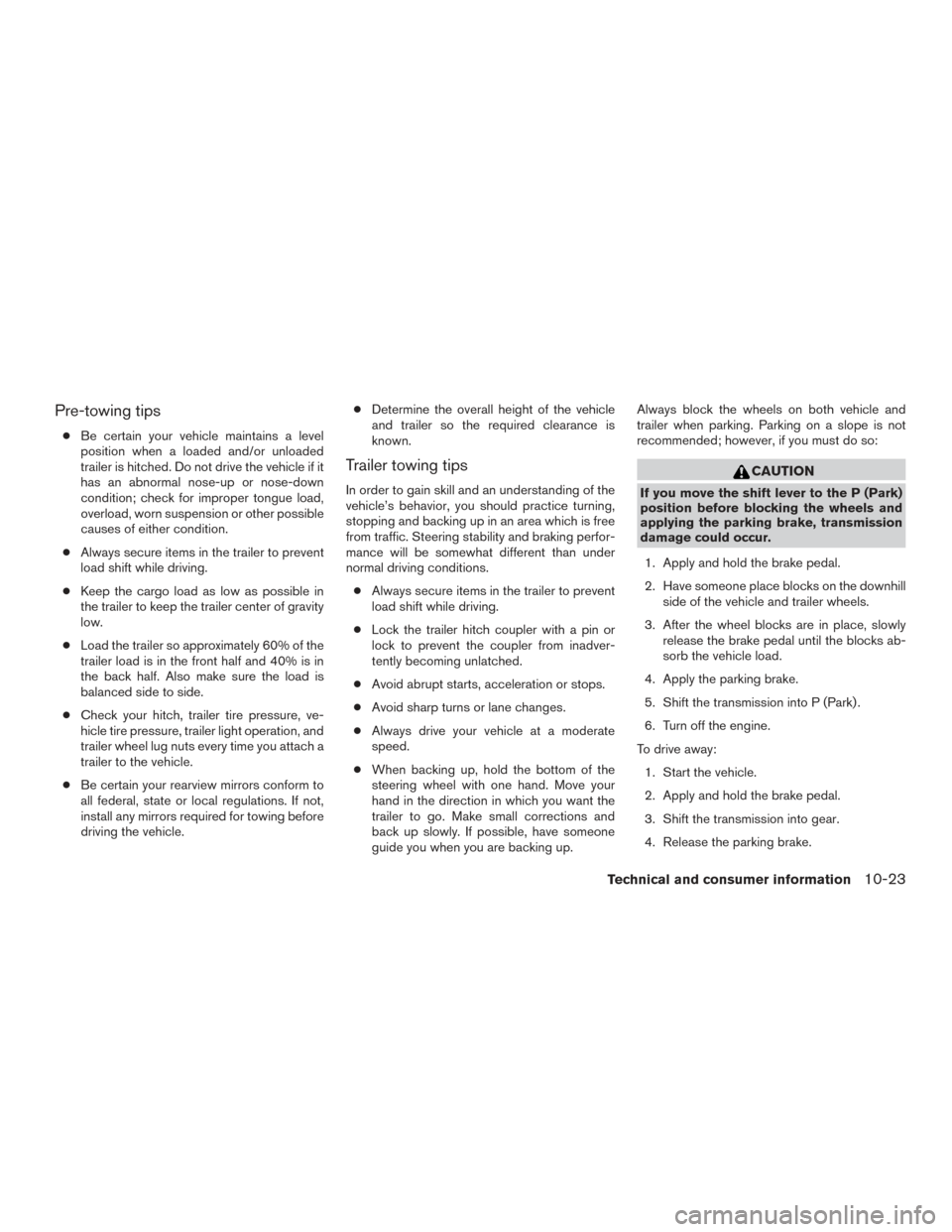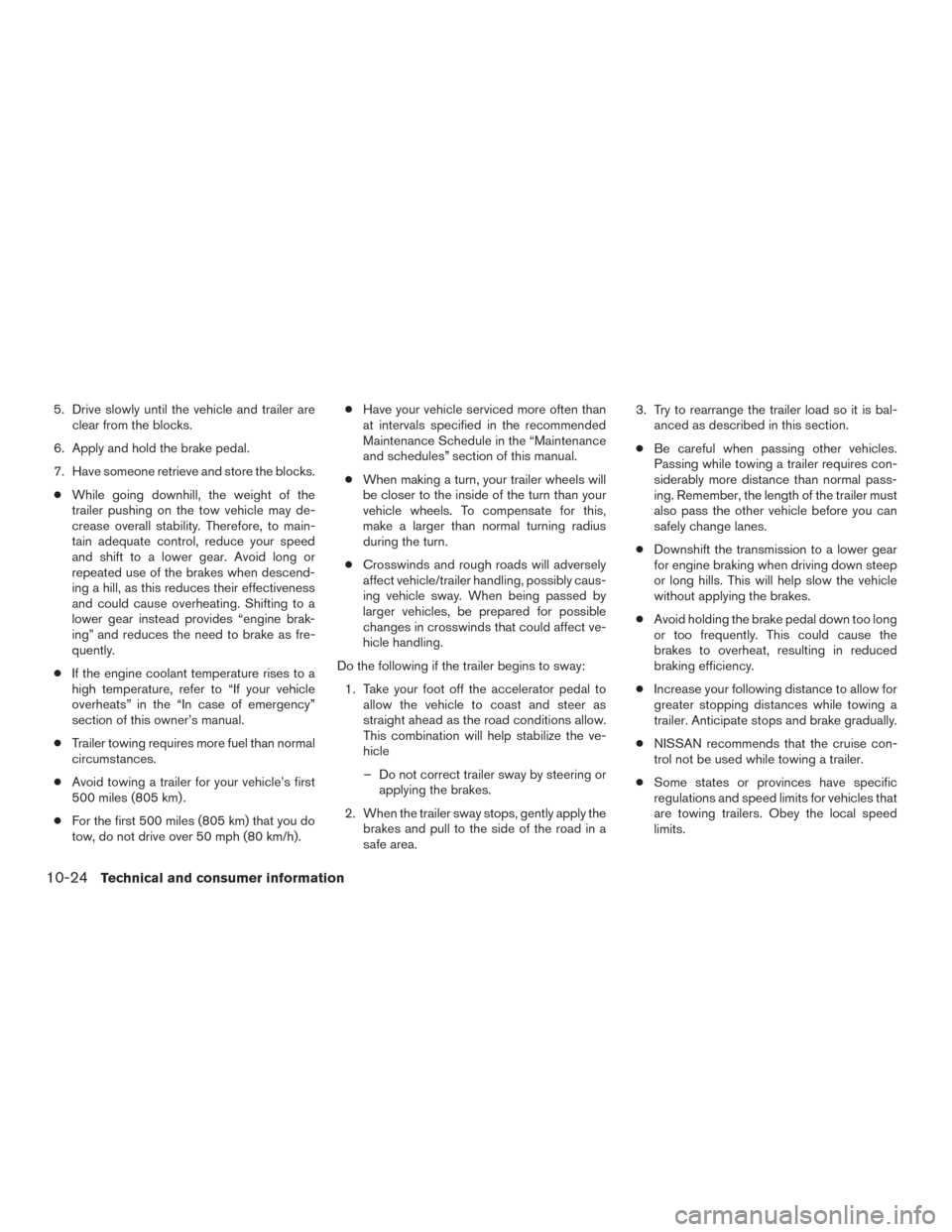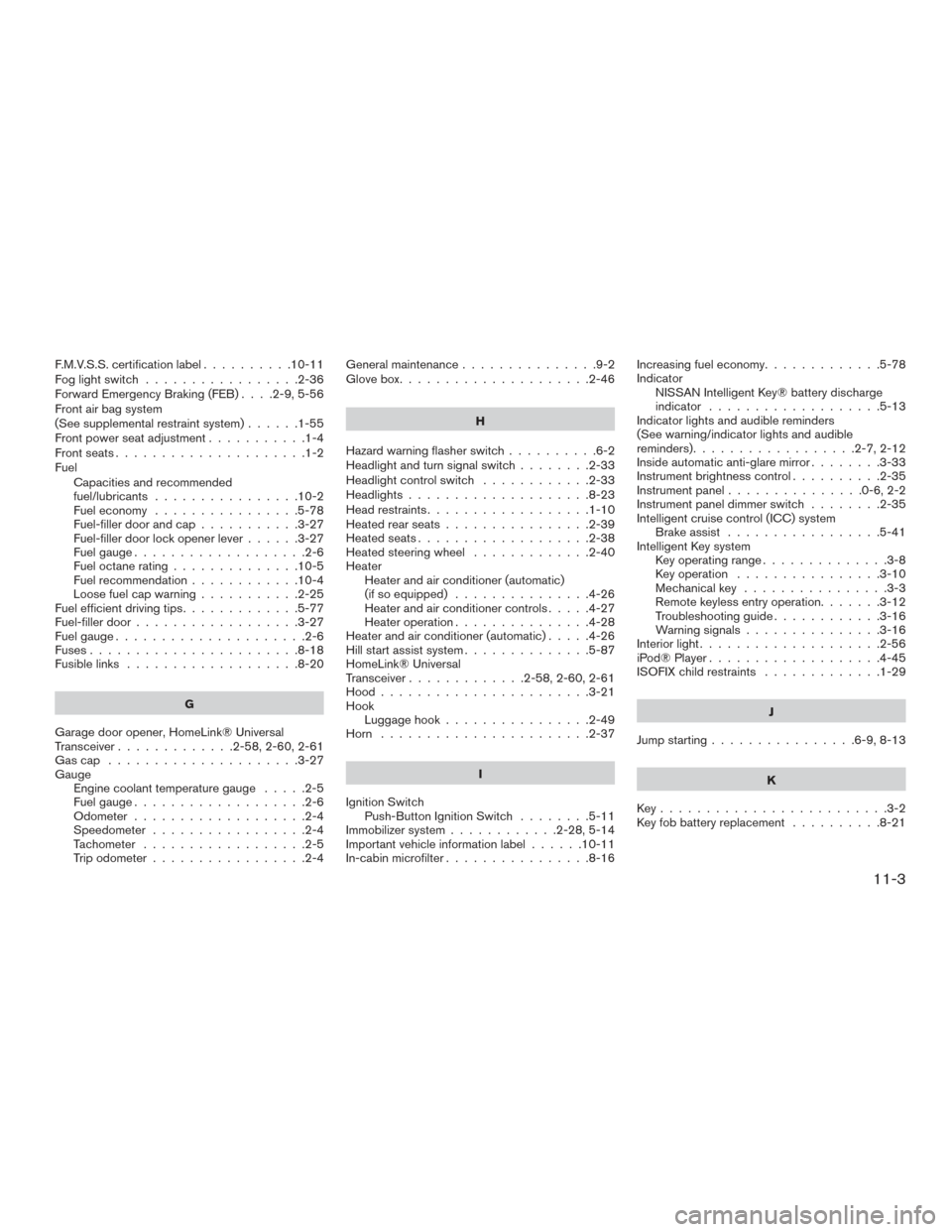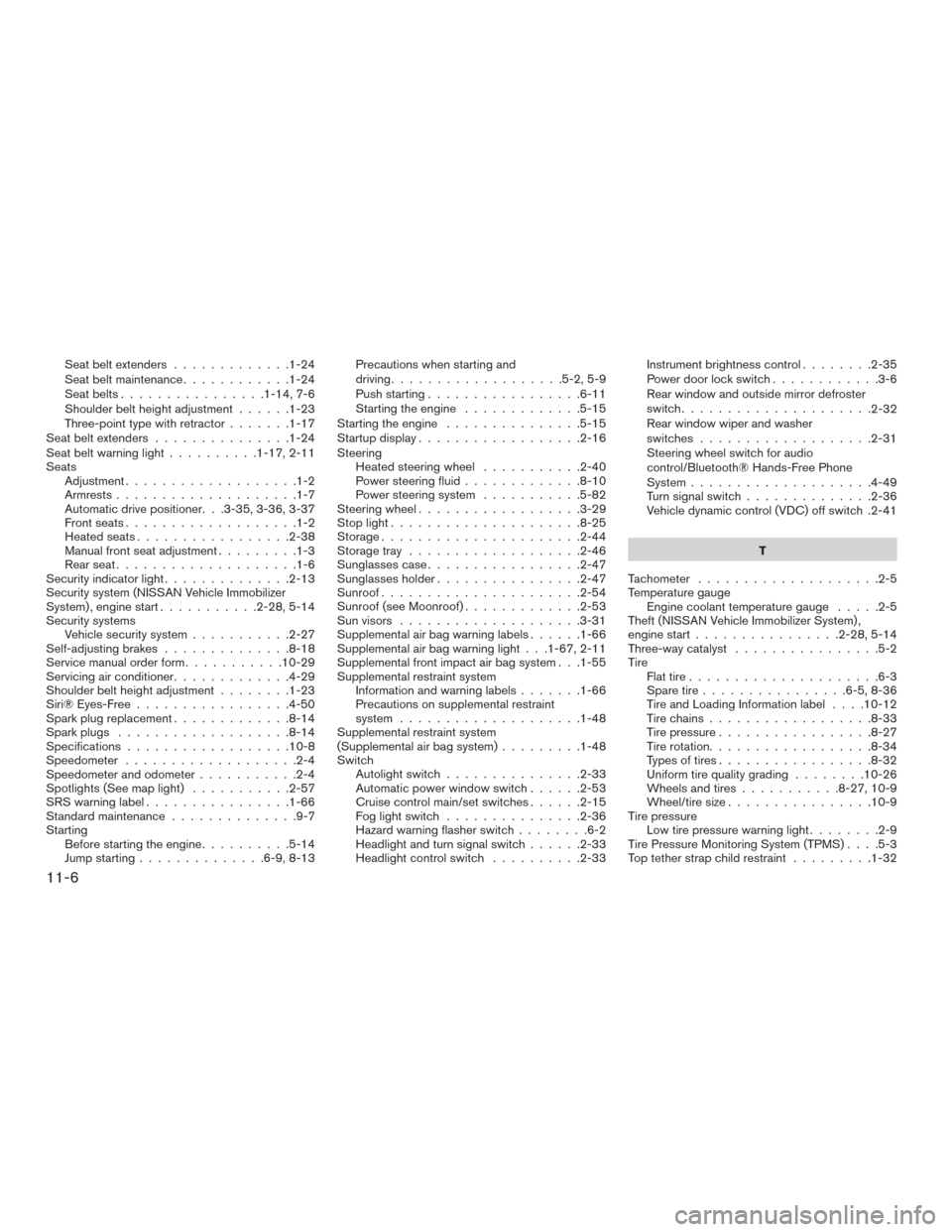2017 NISSAN MURANO steering wheel
[x] Cancel search: steering wheelPage 450 of 466

Pre-towing tips
●Be certain your vehicle maintains a level
position when a loaded and/or unloaded
trailer is hitched. Do not drive the vehicle if it
has an abnormal nose-up or nose-down
condition; check for improper tongue load,
overload, worn suspension or other possible
causes of either condition.
● Always secure items in the trailer to prevent
load shift while driving.
● Keep the cargo load as low as possible in
the trailer to keep the trailer center of gravity
low.
● Load the trailer so approximately 60% of the
trailer load is in the front half and 40% is in
the back half. Also make sure the load is
balanced side to side.
● Check your hitch, trailer tire pressure, ve-
hicle tire pressure, trailer light operation, and
trailer wheel lug nuts every time you attach a
trailer to the vehicle.
● Be certain your rearview mirrors conform to
all federal, state or local regulations. If not,
install any mirrors required for towing before
driving the vehicle. ●
Determine the overall height of the vehicle
and trailer so the required clearance is
known.
Trailer towing tips
In order to gain skill and an understanding of the
vehicle’s behavior, you should practice turning,
stopping and backing up in an area which is free
from traffic. Steering stability and braking perfor-
mance will be somewhat different than under
normal driving conditions.
● Always secure items in the trailer to prevent
load shift while driving.
● Lock the trailer hitch coupler with a pin or
lock to prevent the coupler from inadver-
tently becoming unlatched.
● Avoid abrupt starts, acceleration or stops.
● Avoid sharp turns or lane changes.
● Always drive your vehicle at a moderate
speed.
● When backing up, hold the bottom of the
steering wheel with one hand. Move your
hand in the direction in which you want the
trailer to go. Make small corrections and
back up slowly. If possible, have someone
guide you when you are backing up. Always block the wheels on both vehicle and
trailer when parking. Parking on a slope is not
recommended; however, if you must do so:
CAUTION
If you move the shift lever to the P (Park)
position before blocking the wheels and
applying the parking brake, transmission
damage could occur.
1. Apply and hold the brake pedal.
2. Have someone place blocks on the downhill side of the vehicle and trailer wheels.
3. After the wheel blocks are in place, slowly release the brake pedal until the blocks ab-
sorb the vehicle load.
4. Apply the parking brake.
5. Shift the transmission into P (Park) .
6. Turn off the engine.
To drive away: 1. Start the vehicle.
2. Apply and hold the brake pedal.
3. Shift the transmission into gear.
4. Release the parking brake.
Technical and consumer information10-23
Page 451 of 466

5. Drive slowly until the vehicle and trailer areclear from the blocks.
6. Apply and hold the brake pedal.
7. Have someone retrieve and store the blocks. ● While going downhill, the weight of the
trailer pushing on the tow vehicle may de-
crease overall stability. Therefore, to main-
tain adequate control, reduce your speed
and shift to a lower gear. Avoid long or
repeated use of the brakes when descend-
ing a hill, as this reduces their effectiveness
and could cause overheating. Shifting to a
lower gear instead provides “engine brak-
ing” and reduces the need to brake as fre-
quently.
● If the engine coolant temperature rises to a
high temperature, refer to “If your vehicle
overheats” in the “In case of emergency”
section of this owner’s manual.
● Trailer towing requires more fuel than normal
circumstances.
● Avoid towing a trailer for your vehicle’s first
500 miles (805 km) .
● For the first 500 miles (805 km) that you do
tow, do not drive over 50 mph (80 km/h). ●
Have your vehicle serviced more often than
at intervals specified in the recommended
Maintenance Schedule in the “Maintenance
and schedules” section of this manual.
● When making a turn, your trailer wheels will
be closer to the inside of the turn than your
vehicle wheels. To compensate for this,
make a larger than normal turning radius
during the turn.
● Crosswinds and rough roads will adversely
affect vehicle/trailer handling, possibly caus-
ing vehicle sway. When being passed by
larger vehicles, be prepared for possible
changes in crosswinds that could affect ve-
hicle handling.
Do the following if the trailer begins to sway: 1. Take your foot off the accelerator pedal to allow the vehicle to coast and steer as
straight ahead as the road conditions allow.
This combination will help stabilize the ve-
hicle
– Do not correct trailer sway by steering or applying the brakes.
2. When the trailer sway stops, gently apply the brakes and pull to the side of the road in a
safe area. 3. Try to rearrange the trailer load so it is bal-
anced as described in this section.
● Be careful when passing other vehicles.
Passing while towing a trailer requires con-
siderably more distance than normal pass-
ing. Remember, the length of the trailer must
also pass the other vehicle before you can
safely change lanes.
● Downshift the transmission to a lower gear
for engine braking when driving down steep
or long hills. This will help slow the vehicle
without applying the brakes.
● Avoid holding the brake pedal down too long
or too frequently. This could cause the
brakes to overheat, resulting in reduced
braking efficiency.
● Increase your following distance to allow for
greater stopping distances while towing a
trailer. Anticipate stops and brake gradually.
● NISSAN recommends that the cruise con-
trol not be used while towing a trailer.
● Some states or provinces have specific
regulations and speed limits for vehicles that
are towing trailers. Obey the local speed
limits.
10-24Technical and consumer information
Page 460 of 466

F.M.V.S.S. certification label..........10-11
Foglightswitch .................2-36
Forward Emergency Braking (FEB) ....2-9,5-56
Front air bag system
(See supplemental restraint system) ......1-55
Front power seat adjustment ...........1-4
Frontseats.....................1-2
Fuel Capacities and recommended
fuel/lubricants ................10-2
Fuel economy ................5-78
Fuel-filler door and cap ...........3-27
Fuel-filler door lock opener lever ......3-27
Fuel gauge ...................2-6
Fuel octane rating ..............10-5
Fuel recommendation ............10-4
Loose fuel cap warning ...........2-25
Fuel efficient driving tips .............5-77
Fuel-filler door ..................3-27
Fuel gauge .....................2-6
Fuses.......................8-18
Fusible links ...................8-20
G
Garage door opener, HomeLink® Universal
Transceiver.............2-58,2-60,2-61
Gascap .....................3-27
Gauge Engine coolant temperature gauge .....2-5
Fuel gauge ...................2-6
Odometer ...................2-4
Speedometer .................2-4
Tachometer ..................2-5
Trip odometer .................2-4 General maintenance
...............9-2
Glovebox.....................2-46
H
Hazard warning flasher switch ..........6-2
Headlight and turn signal switch ........2-33
Headlight control switch ............2-33
Headlights ....................8-23
Head restraints ..................1-10
Heated rear seats ................2-39
Heated seats ...................2-38
Heated steering wheel .............2-40
Heater Heater and air conditioner (automatic)
(if so equipped) ...............4-26
Heater and air conditioner controls .....4-27
Heater operation ...............4-28
Heater and air conditioner (automatic) .....4-26
Hill start assist system ..............5-87
HomeLink® Universal
Transceiver .............2-58,2-60,2-61
Hood .......................3-21
Hook Luggage hook ................2-49
Horn .......................2-37
I
Ignition Switch Push-Button Ignition Switch ........5-11
Immobilizer system ............2-28,5-14
Important vehicle information label ......10-11
In-cabin microfilter ................8-16 Increasing fuel economy
.............5-78
Indicator NISSAN Intelligent Key® battery discharge
i
ndicator ...................5-13
Indicator lights and audible reminders
(See warning/indicator lights and audible
reminders)..................2-7,2-12
Inside automatic anti-glare mirror ........3-33
Instrument brightness control ..........2-35
Instrumentpanel...............0-6,2-2
Instrument panel dimmer switch ........2-35
Intelligent cruise control (ICC) system Brake assist .................5-41
Intelligent Key system Key operating range ..............3-8
Key operation ................3-10
Mechanical key ................3-3
Remote keyless entry operation.......3-12
Troubleshooting guide ............3-16
Warning signals ...............3-16
Interior light ....................2-56
iPod®Player...................4-45
ISOFIX child restraints .............1-29
J
Jump starting ................6-9,8-13
K
Key.........................3-2
Key fob battery replacement ..........8-21
11-3
Page 463 of 466

Seat belt extenders.............1-24
Seat belt maintenance ............1-24
Seat belts ................1-14,7-6
Shoulder belt height adjustment ......1-23
Three-point type with retractor .......1-17
Seat belt extenders ...............1-24
Seatbeltwarninglight..........1-17,2-11
Seats Adjustment ...................1-2
Armrests....................1-7
Automatic drive positioner. . .3-35, 3-36, 3-37
Frontseats...................1-2
Heatedseats.................2-38
Manual front seat adjustment .........1-3
Rear seat ....................1-6
Security indicator light ..............2-13
Security system (NISSAN Vehicle Immobilizer
System) , engine start ...........2-28,5-14
Security systems Vehicle security system ...........2-27
Self-adjusting brakes ..............8-18
Service manual order form ...........10-29
Servicing air conditioner .............4-29
Shoulder belt height adjustment ........1-23
Siri® Eyes-Free .................4-50
Spark plug replacement .............8-14
Spark plugs ...................8-14
Specifications ..................10-8
Speedometer ...................2-4
Speedometer and odometer ...........2-4
Spotlights(Seemaplight) ...........2-57
SRS warning label ................1-66
Standardmaintenance..............9-7
Starting Before starting the engine ..........5-14
Jump starting ..............6-9,8-13 Precautions when starting and
driving
...................5-2,5-9
Push starting .................6-11
Starting the engine .............5-15
Starting the engine ...............5-15
Startup display ..................2-16
Steering Heated steering wheel ...........2-40
Power steering fluid .............8-10
Power steering system ...........5-82
Steeringwheel..................3-29
Stoplight.....................8-25
Storage......................2-44
Storage tray ...................2-46
Sunglassescase.................2-47
Sunglassesholder................2-47
Sunroof......................2-54
Sunroof(seeMoonroof).............2-53
Sun visors ....................3-31
Supplemental air bag warning labels ......1-66
Supplemental air bag warning light . . .1-67, 2-11
Supplemental front impact air bag system . . .1-55
Supplemental restraint system Information and warning labels .......1-66
Precautions on supplemental restraint
system ....................1-48
Supplemental restraint system
(Supplemental air bag system) .........1-48
Switch Autolightswitch...............2-33
Automatic power window switch ......2-53
Cruise control main/set switches ......2-15
Foglightswitch ...............2-36
Hazard warning flasher switch ........6-2
Headlight and turn signal switch ......2-33
Headlight control switch ..........2-33 Instrument brightness control
........2-35
Power door lock switch ............3-6
Rear window and outside mirror defroster
switch .....................
2-32
Rear window wiper and washer
switches ...................2-31
Steering wheel switch for audio
control/Bluetooth® Hands-Free Phone
System ....................4-49
Turnsignalswitch..............2-36
Vehicle dynamic control (VDC) off switch .2-41
T
Tachometer ....................2-5
Temperature gauge Engine coolant temperature gauge .....2-5
Theft (NISSAN Vehicle Immobilizer System) ,
engine start ................2-28,5-14
Three-way catalyst ................5-2
Tire Flat tire .....................6-3
Spare tire ................6-5,8-36
Tire and Loading Information label ....10-12
Tire chains ..................8-33
Tire pressure .................8-27
Tire rotation..................8-34
Types of tires .................8-32
Uniform tire quality grading ........10-26
Wheels and tires ...........8-27,10-9
Wheel/tire size ................10-9
Tire pressure Low tire pressure warning light ........2-9
Tire Pressure Monitoring System (TPMS) ....5-3
Top tether strap child restraint .........1-32
11-6